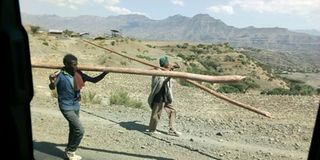Prime
Aksum: Entry into Ethiopia’s rich heritage

Men walk in Lalibela Ethiopia and (below) the city of Gondar is famous for its palaces and castles like Fasil Ghebi, residence of the Ethiopian emperor Fasilidas and his successors during the 16th and 17th centuries. Bottom is the Church of St Mary of Zion. Photos/ Edgar R Batte
What you need to know:
Wonders. writes
If there is one big lesson the lockdown has taught us, nothing is a given; life can change overnight. As such, nothing is a constant as life slows down.
God’s sense of humour, if you ask me. As we morph back into normalcy, I implore you to consider travel as a new hobby, if it wasn’t. Start by getting to explore the next town then another, far away and later on, lands beyond our borderline.
If heritage ticks your interests, Ethiopia is one place worth including on your travel list. The destination will be eye-opening; it is the land of origins and the cradle land of mankind.
The opportunity to visit Aksum in northern Ethiopia was a telling excursion as we were walked and talked through old structures, the Ruins of the Aksumite Empire that came into existence in 300BC.
The buildings are a showcase of the old age stories, some algae seems a new coating. They were constructed from stone and bear inscriptions.
The stone
The people of Aksum, as we learnt from our guides, were traders who did so with Egyptians, Arabs and Indians in items such as ivory, gold, copper, silver and slaves.
In their book, titled A History of Ethiopia in Pictures which is available for purchase at the temples and gift shops, authors Geoffrey Last, Richard Pankhurst and Eric Robson, write that the Aksumites for a time, were under strong Greek influence and used Greek as well as Ge’ez, an ancient South Semitic language of the Ethiopic branch.
“The Aksumite empire with its many stone buildings, its stone reservoirs, its stelae (upright stone slabs or columns typically bearing a commemorative inscription or relief design, often serving as gravestones) , as well as its locally made coins, produced much material which has survived the passion of yoke and is therefore available today for archaeologists to study,” the book states, in part.
The marvel is in the skill and passion in putting together palaces.

Sights
A keen eye will be drawn to the ornamental decoration on different walls, of living rooms, corridors and ceilings. The precision in wood carving and precious stone is admirable. Ask your guide to take you through the wounding Rock Grace, to the Thrones, Aksumite Reservoir, Old Seyon Cathedral and the New Seyon Cathedral. You will learn of how the Aksumite Empire expanded from only a small area to stand its presence in much of the northern part of the Horn of Africa, as taken from the outlook of the country on the continental map.
Everything is done to continue preserving this medieval history. As such, in certain places, especially with precious art and carvings, you will be requested not to take pictures, not to give chance to replicates.
A review by Zeit Ethiopia Tour, a local tour and travel operator in Ethiopia, states that Aksum is also scenic in the highlands, the most important sights of the city are historical. It explains that above all, the famous field of stelae Aksum is worth a visit, also the Church of Our Lady Mary of Zion may not be missed.
In other times, you will be able to immerse yourself in the baths and the palace of the Queen of Sheba and once again recognize the splendour and influence that prevailed here.
“The stelae, tombs and impressive ruins characterise Aksum and make it immediately clear why the old town was declared a UNESCO World Heritage Site. Numerous stelae and obelisks characterize Aksum and represent a special attraction in the city dar. The famous Stelenpark of Axum should be visited with the impressive stone pillars,” Zeit observes.
Travellers say
According to Tripadvisor travellers, the best ways to experience The Ruins of Aksum: are, five days in Aksum, would also lead you to Lalibela, Tigray churches and Danakil.
Danakil is one of the most geologically active regions with three tectonic plates meeting at the Afar Triple Junction. The unique aspect is that when tectonic plates move apart like at Danakil, it creates, hot springs, geysers and fissures in the ground.

“Our tour is unique as it is well-arranged including “must visit” historic sites of Lalibela and Axum together with the breath-taking landscape in Tigray which we deliver all with Ethiopian hospitality and touch,” reads a review by Ethio Travel and Tours on by TripAdvisor.
Another five days will lead you from Bahir Dar to Gondar, Aksum and Labibela for about Shs3.8m. If you are to stay within Aksum, you will spend Shs382, 724. For six days of touring Ethiopian historical places, by flight, will cost you at least Shs3.3m. As you go along, you will be served to a strong or midrange taste of coffee, which is part of Ethiopian culture. Take a sip, to keep you awake during the history lesson that is Ethiopia’s rich heritage.
They say
According to Tripadvisor travellers, the best ways to experience The Ruins of Aksum: are, five days in Aksum, would also lead you to Lalibela, Tigray churches and Danakil.
Danakil is one of the most geologically active regions with three tectonic plates meeting at the Afar Triple Junction.




